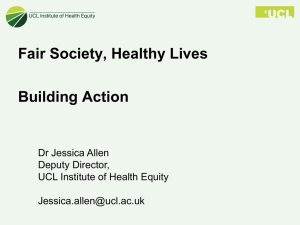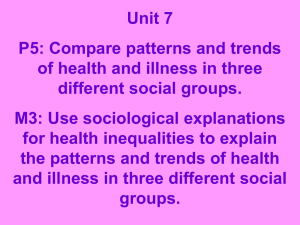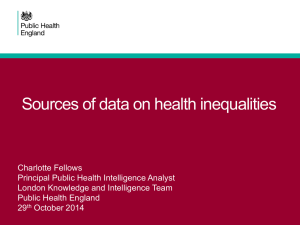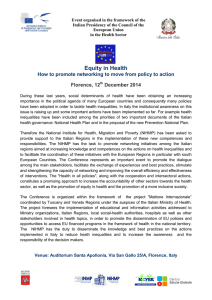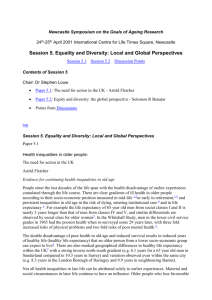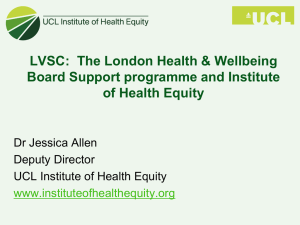EU Structural and Investment Funds
advertisement
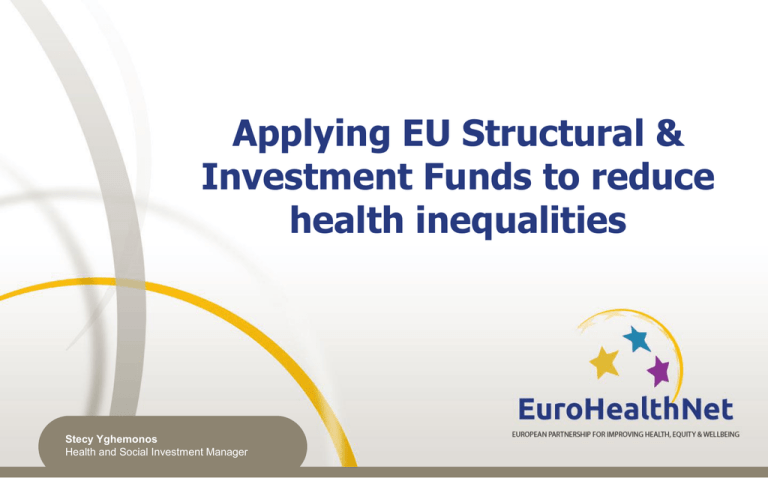
Applying EU Structural & Investment Funds to reduce health inequalities Stecy Yghemonos Health and Social Investment Manager EuroHealthNet European Network of health promotion and disease prevention bodies – Over 40 member/partner organisations Italy: Veneto and Tuscany regions – Focus on reduction of health inequalities – Coordinator of / involved in various EU projects e.g. Joint Action on Health Inequalities Making the links between policy development processes within MS and at EU level – EU Cohesion Policy The Social Determinants of Health Approach The EU 2020 Strategy Jobs Education Social Inclusion Environment Research/Innovation + Loads of EU cooperation mechanisms, programmes and funding streams The way we work Our Mission Contribute to Health Equity between and within EU countries Combat Non-Communicable Diseases Health Promotion and Disease Prevention for sustainable health systems Project Outcomes Evidence Share good practices among Member States Recommendations Implement/Document Advocacy Partnerships Health across policies Inform policy makers Communication (newsletter, websites) Raise awareness Equity Action - Regional Work Strand EuroHealthNet coordinated: • Regional network of 30 regions in 10 MS – Regional Case Studies & Structural Funds Review • SF Review, by regions and national partners Aim: Develop knowledge and gather evidence on how EU Structural Funds can be used to reduce health inequalities www.health-inequalities.eu EU Cohesion Policy ‘Regional Policy of the EU’ • Main objective: to reduce the significant gap between less-favoured regions and affluent ones in Europe • Supports: job creation, competitiveness, economic growth, improved quality of life and sustainable development • Focus: Economic, Social & Territorial disparities EU Structural and Investment Funds • Financial Mechanism to implement Cohesion Policy • Renewed every 7 years (current period: 2014-2020) Budget 2014-2020 325 billion euros • More than 1/3 of total EU budget • 2nd largest EU financing mechanism • Vote in Parliament on 18-21 Nov 2013 (after more than a year of negotiations) 11 Themes (2014-2020) 1. Research & Innovation 2. Communication Technologies 3. SMEs 4. Low-carbon economy 5. Climate change 6. Environment 7. Sustainable Transport 8. Employment 9. Social Inclusion & Poverty 10. Education, Skills & Life-long learning 11. Capacity Building Europe 2020: Smart, Sustainable & Inclusive Growth European Regions Budget Cohesion Policy 2014-2020 Funding Programmes ERDF • Economic change, regional development, enhanced competitiveness and territorial co-operation • Funding of ‘hard projects’ ESF • Enhancing access to employment and participation in the labour market, and reinforcing social inclusion • Funding of ‘soft projects’ CF • Environment and trans-European transport networks • MS with a GNI of less than 90% of the EU average EAFRD • Agriculture and Rural Development EMFF • Maritime and Fisheries Structural Funds in Italy (1) Budget 2014-2020 • €32.8 billion 4 strategic objectives divided into 15 priorities: • Developing an innovation-friendly business environment. • Putting in place high-performance infrastructures and efficient management of natural resources. • Increasing labour market participation, promoting social inclusion and improving the quality of human capital. • Supporting the quality, effectiveness and efficiency of the public administration. Structural Funds in Italy (2) Total allocations of Cohesion Policy 2014-2020 (billion € , current prices) European Territorial Cooperation Less developed regions Transition regions More developed regions Youth Employment Initiative Total 1.1 22.3 1.1 7.7 0.567 32.8 How can EU Structural & Investment Funds be used to reduce health inequalities? Examples identified • • Systematic approaches – Health (equity) as a selection / evaluation criteria – Health (equity) as a cross-cutting SF theme – Leveraging existing approaches Projects and Programmes – … Specifically focused on reducing health inequalities – … Addressing underlying determinants of health by: • Promoting social inclusion and combating poverty • Promoting employment and supporting labour mobility • Investing in education and life-long-learning • Urban regeneration and pollution • Stimulating production of innovation products that benefit vulnerable people Two concrete examples • Italy: POAT Salute: “Plan for Re-organisation and Capacity Building” of Southern Italy’s health-care systems – Strengthens capacities of the public administration to: • cope with social inequalities in health • evaluate interventions that take into account different SEGs • apply equity lens systematically in health programming • Finland: Developing Well-Being in Northern Ostrobothnia – Take forward health equity related objectives in the Region’s Welfare Programme – Focused on getting HI written in strategies + engaging stakeholders to reducing health inequalities. – Has provided actors with a mandate to reduce HI Conclusions • The opportunities are there, but (often) being lost – Health related expenditure tend to go to healthcare (infrastructures, hospitals, biomedical research) – Public health has not been regarded as a key stakeholder, & must get more involved in key processes – Little awareness amongst public health sector • There is a need for capacity building and training among public health professionals & beyond around the use of SF to achieve public health objectives and reduce health inequalities Some tips… It’s a complicated process, so Familiarise yourself with the Structural Funds processes as well as with your country and region’s priorities. Contact your Managing Authority! See http://ec.europa.eu/regional_policy/manage/authority/authorities.cfm Don’t take an ad-hoc approach, Be strategic in efforts to exploit the opportunities presented by Structural Funds, and ensure that they are spent in ways that advance public health objectives, by e.g. building capacities Don’t reinvent, build Partnerships with organisations and sectors who are already involved in/experience with SF To apply for Structural Funds, Think outside of the box and develop project proposals that are in line with the EU 2020 objectives, and address country specific recommendations (e.g. making healthcare systems less centered on hospital care) Structural Funds Analysis Report www.health-inequalities.eu Structural Funds online Guidance Tool www.fundsforhealth.eu Thank you! Stecy Yghemonos s.yghemonos@eurohealthnet.eu

